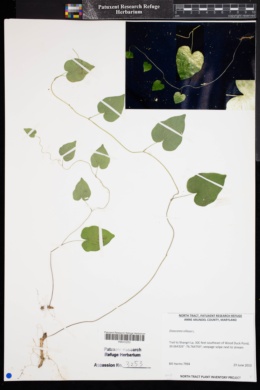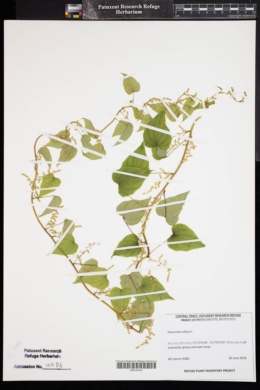Dioscorea villosa
|
Dioscorea villosa L.
 (redirected from: Dioscorea quaternata var. glauca (Muhl. ex Bartlett) Fernald) (redirected from: Dioscorea quaternata var. glauca (Muhl. ex Bartlett) Fernald) |
|
|
Family: Dioscoreaceae
Wild Yam, more...colic root, yam root, fourleaf yam
[Dioscorea glauca Muhl. ex Bartlett, moreDioscorea hirticaulis Bartlett, Dioscorea hirticaulus Bartlett, Dioscorea paniculata var. glabrifolia Bartlett, Dioscorea quaternata J.F. Gmel., Dioscorea quaternata var. glauca (Muhl. ex Bartlett) Fernald, Dioscorea quaternata var. quaternata , Dioscorea sativa L., nom. cons., Dioscorea villosa f. glabrifolia (Bartlett) Fernald] |
Plants rhizomatous; rhizomes brownish, unbranched or highly branched, linear to irregularly contorted, 0.5-1.5 cm or more diam., nodes not articulate. Stems longitudinally grooved or sometimes narrowly winged, usually terete in cross section, 1-7 m, ± rigid proximally, or flexible, glabrous or rarely with sparse pubescence, wings when present less than 1 mm and stems polygonal. Leaves alternate, subopposite, subverticillate, or in verticels of 3-7 proximally, due to suppression of proximal inter-nodes (esp. in woodland understory), always alternate distally, 3-13 × 2-13 cm, ca. as long as wide; petiole ridged or narrowly winged, 3-14 cm, glabrous or puberulent at pulvinus, base not clasping; blade green to ± glaucous, (7-)9-11-veined, ovate-cordate, abaxial surface sometimes ± glandular, or sparsely or sometimes densely pubescent to glabrous, base with sinus rounded, acute, or ± truncate basally, margins entire or repand, apex acute to acuminate, occasionally mucronate. Staminate inflorescences solitary in leaf axils, rarely terminal, spicate or branched; cymes sessile, bearing 1-3 sessile flowers, braceolate, internodes between cymes 1-8 mm, bracteoles ca. 1 mm; rachis 2-30 cm, secondary axes to 15 cm, robust plants occasionally branched to third order, axes subtended by linear-lanceolate bracts 1-3 mm. Pistillate inflorescences solitary, 4-18-flowered, 4-20 cm, internodes 6-12 mm. Staminate flowers: perianth greenish white, appearing darker in some specimens due to presence of irregularly distributed tannin crystals, rotate-campanulate to funnelform, 1-2(-3) mm diam.; tepals ± glandular, ovate-elliptic, margins hyaline, apex rounded or acute; stamens in 2 subequal whorls, erect; anthers ca. ½ length of filaments, thecae distinct, widely spreading. Pistillate flowers: perianth greenish white, rotate-campanulate, 2-4 mm wide; tepals as in staminate flowers; staminodes 6, differentiated into anthers and filaments, less than 1/2 length of fertile stamens. Capsules greenish gold, ovoid to obovoid to obreniform, 1-3 × 1-3.5 cm, varying continously in size, occasionally ± glaucous. Seeds generally 2 per locule, rarely 1, 5-18 mm. 2n = 20, 36, 54, 60. Flowering mid spring--summer; fruiting late summer. Borders of bogs, swamps, marshes, river and lake margins, creek bottoms, sandy or rocky soils, moist or dry woods, hammocks, thickets, limestone or talus slopes, roadsides; 0--1500 m; Ont.; Ala., Ark., Conn., Del., D.C., Fla., Ga., Ill., Ind., Iowa, Kans., Ky., La., Md., Mass., Mich., Minn., Miss., Mo., Nebr., N.J., N.Y., N.C., Ohio, Okla., Pa., R.I., S.C., Tenn., Tex., Vt., Va., W.Va., Wis. Dioscorea villosa is a highly polymorphic species, exhibiting complex patterns of variation across its geographic range. Characters that have been used previously to delineate taxonomic boundaries within this complex-pubescence, glaucousness, rhizome thickness and shape, length of internodes within the inflorescence, arrangement of proximal leaves, geometry of the stem, and fruit and seed size/shape-fail when individuals from all parts of the range and specimens representing both apical and basal portions of single stems can be examined. At its morphological extremes, D. villosa comprises 1) small vines with tightly congested inflorescences, winged stems, and variously pubescent leaves, occurring in bogs and branch swamps; and 2) robust plants, rigid at the base, the proximal leaves verticillate with large, glaucous blades, from the axils of which arise lax spikes or panicles, inhabiting rocky, upland woods and steep talus slopes. As one ascends from the Atlantic Coastal Plain through the Appalachians, continuing westward to the Great Lakes region, south to the Ozarks, and east to the branch swamps of Georgia, particular morphologies are associated with particular ecological conditions, independent of geography. As well as the morphological extremes, every intermediate condition of leaf, stem, and inflorescence architecture can be found, in all combinations, and variation may be encountered even within individual plants. What sort of genetic structure underlies these patterns of morphological diversity remains an open question. That there is a significant degree of genetic variability within the complex is evident from the chromosome counts thus far reported. Further research is needed to shed light on patterns of gene flow in the complex, and garden studies would be instructive as to the limits of individual plasticity. At present, I can find no natural gaps in the variation between the plants that have been called (albeit ambiguously; see H. H. Bartlett 1910) D. villosa and those called D. quaternata, and therefore I am treating the complex as a single species.
Perennial rhizome-bearing herbaceous vine to 5 m tall Stem: grooved to narrowly winged, usually hairless, twining counterclockwise. Leaves: alternate, lowermost leaves sometimes whorled, on a ridged to narrowly winged stalk, 3 - 13 cm long, 2 - 13 cm wide, heart-shaped to nearly egg-shaped with a pointed tip, non-toothed or rarely very shallowly lobed or toothed, seven- to eleven-veined, curving downward on the sides, sometimes hairy beneath. Flowers: either male or female, found on separate plants (dioecious). Inflorescences are borne solitary in leaf axils and formed by short widely branched spikes, with male inflorescences 4 - 20 cm long and female inflorescences 5 - 10 cm long. Individual flowers tiny with six yellowish green to white tepals. Fruit: a 3-winged capsule, greenish gold, 1 - 3 cm long, 1 - 3.5 cm wide, egg- to kidney-shaped and sometimes inversely egg-shaped, opening along each of three cavities to reveal two 7 - 18 mm wide, flat, winged seeds. Similar species: No information at this time. Flowering: mid June to late July Habitat and ecology: This vine is commonly found where railroad property meets wooded areas and in woodlands, preferring moist soils. Occurence in the Chicago region: native Notes: This species is highly variable across its range. See the link below for more information. Etymology: Dioscorea was named after Pedanis Dioscorides, a first century Greek physician, botanist, and pharmacologist. Villosa means "softly hairy," referring to the soft hairs sometimes present on the lower leaf surface. Author: The Morton Arboretum Much like no. 1 [Dioscorea villosa L.], differing as indicated in the key; frs and seeds avg larger, the valves half-obovate; 2n=36, 54. Moist open woods, thickets, and roadsides; Pa. to Ind. and Mo., s. to Fla. and La., chiefly in the Appalachian region. May. Plants with the lvs glaucous beneath have been called var. glauca (Muhl. ex Bartlett) Fernald. (D. g.) Gleason, Henry A. & Cronquist, Arthur J. 1991. Manual of vascular plants of northeastern United States and adjacent Canada. lxxv + 910 pp. ©The New York Botanical Garden. All rights reserved. Used by permission. Rhizomes relatively slender; stems twining counterclockwise, to 5 m, usually glabrous; lvs all or nearly all alternate, the blades glabrous or hairy beneath, cordate- ovate, abruptly acuminate, 5-10 cm, 7-11-nerved; staminate infl widely branched, with 1-4 fls per node; pistillate spikes 5-10 cm, with solitary fls; ovary fusiform, 5-7 mm; fr 16-26 mm, each of the 3 thin valves semi-orbicular or half-ovate; seeds 8-18 mm; 2n=60. Moist open woods, thickets, and roadsides; Conn. and N.Y. to Minn., s. to Fla. and Tex. June, July. Some coastal-plain plants with hairy stem and relatively few-fld infls have been segregated as var. hirticaulis (Bartlett) Ahles. (D. hirticaulis) Gleason, Henry A. & Cronquist, Arthur J. 1991. Manual of vascular plants of northeastern United States and adjacent Canada. lxxv + 910 pp. ©The New York Botanical Garden. All rights reserved. Used by permission. From Flora of Indiana (1940) by Charles C. Deam [Modern treatments consider Dioscorea villosa as a highly variable complex. Deam's treatment divides the complex into four species. [Dioscorea villosa sensu stricto is characterized by alternate lower leaves alternate and glabrous internodes. It is] rather frequent in the northern half of the state, becoming rare or infrequent in the southern part. it prefers moist soil of rich woodland. The lower surface of the blades of all the specimens I have seen is densely pubescent. The glabrous variety has not been found in the state. This species and [Dioscorea hirticaulis (see below)] can be determined definitely only when the whole plant, including the rhizome is at hand. The long, slender rhizomes with few or no laterals are conclusive in naming this species. [Deam's D. glauca has lower leaves in whorls of 5-9 that are glaucous beneath and contorted rhizomes about 10 mm in diameter.] This form prefers slopes of deep ravines and is usually associated with beech and sugar maple. When the leaves are not glaucous beneath this species is difficult to separate from the next species [Dioscorea quaternata]. Small, in his Flora of the Southeastern States, separates them on the size of the staminate flowers. In the typical form the lower surface of the leaves is sparsely pubescent on the principal nerves; the number of leaves in the basal whorl is usually 6, their margins rarely undulate; rhizomes much branched. The wings of the seed of all of my plants are white while those of [D. quaternata] are brown. [Deam's D. hirticaulis has alternate lower leaves and pubescent lower internodes.] This form is found in low woodland that usually is inundated at some time of the year, associated with pin oak, sweet gum, red maple, and black gum. Like all the other Indiana species it has both glabrous and pubescent forms and I have not seen intermediates. I think that they are distinct but a paucity of specimens does not warrant a decision in the matter. [Deam's D. quaternata has lower leaves that are green beneath and in whorls of 4-6; their contorted rhizomes are about 10 mm in diameter. This form is] infrequent in the state within the [southern third of the state]. It is found in wooded ravines, on the crests of chestnut oak ridges, and on the bluffs of the Ohio River. There are two distinct forms in the state. The common and typical form has the lower surface of the leaves glabrous and the other has the lower surface of the leaves rather densely pubescent. ...... Indiana Coefficient of Conservatism: C = 4 Wetland Indicator Status: FAC |















































































